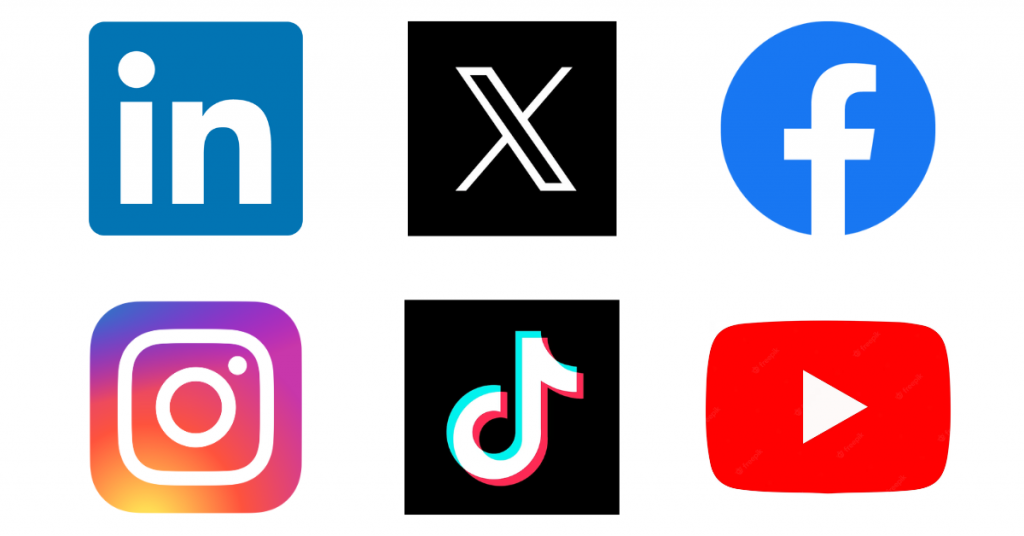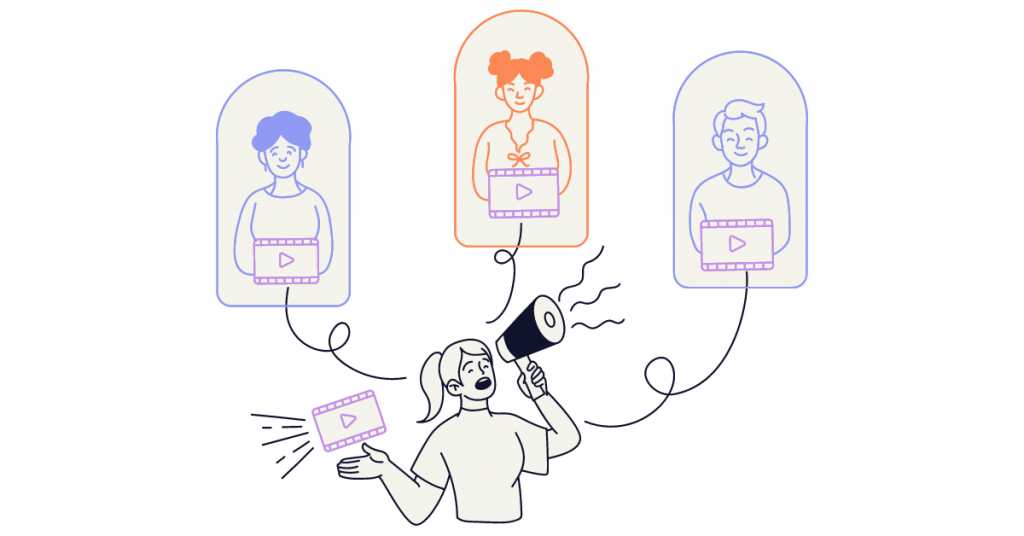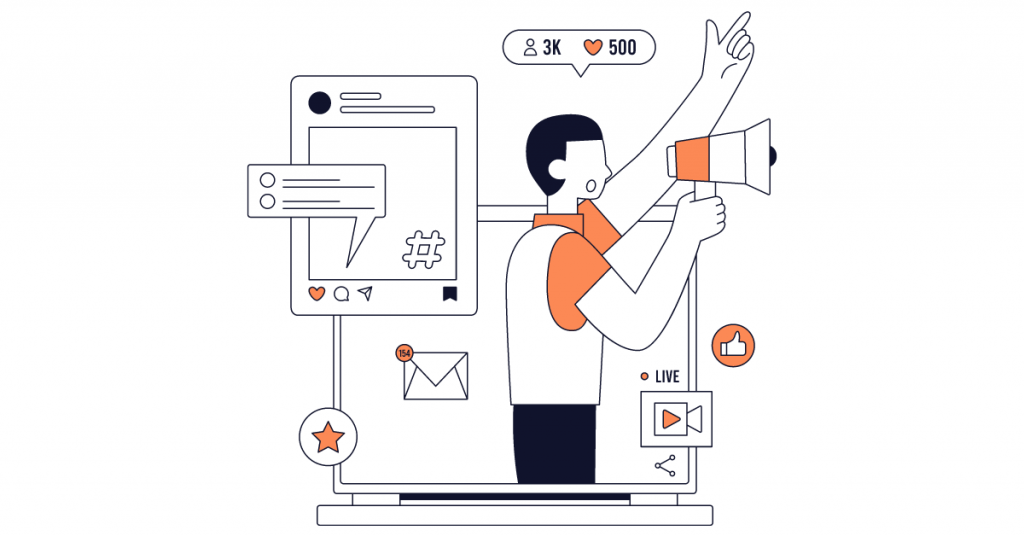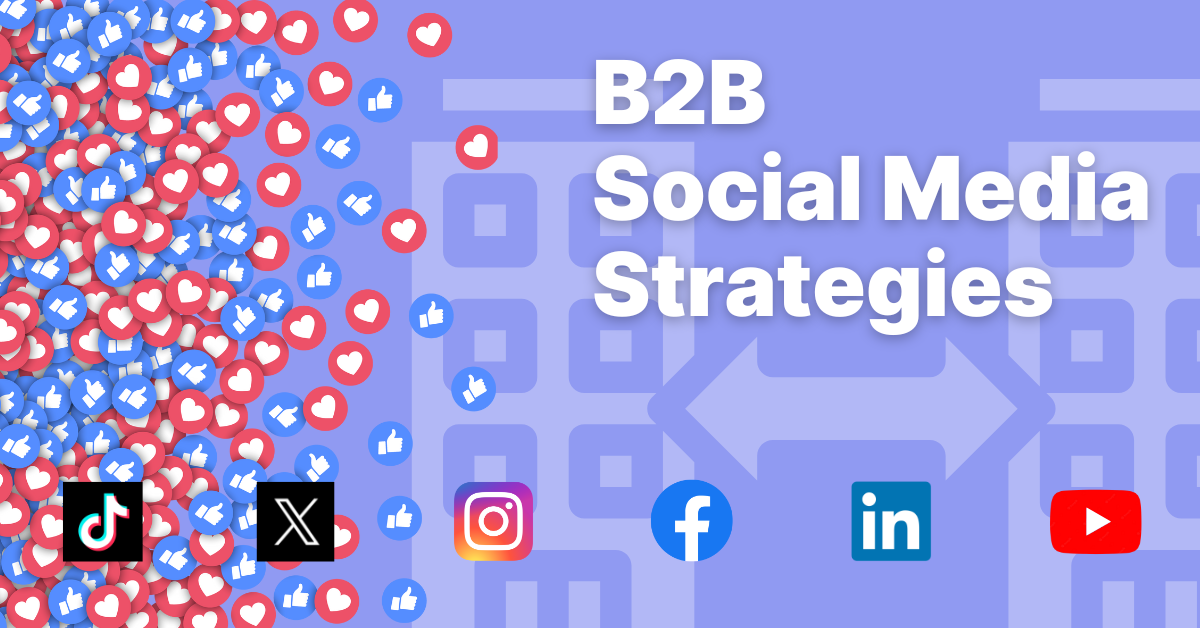Social media has become a powerful tool for businesses. Social media B2B marketing, in particular, has emerged as an essential strategy to reach decision-makers, build relationships, and drive sales. But it’s not just about having a social media presence. It’s about understanding the landscape, setting clear goals, and crafting a strategy tailored to your target audience.
Summary
- Understand the B2B social media landscape and set clear goals to reach customers effectively
- Identify target audiences through buyer personas, content creation, organic/paid strategies
- Leverage analytics tools for continuous improvement & stay ahead by adapting to social media trends.
B2B social media landscape
B2B social media marketing targets other businesses. It promotes products, services, and even career opportunities to the employees of those companies through various social media platforms. With the ability to connect directly with decision-makers, it forms a crucial part of a business’s marketing efforts. In fact, social media is the second most successful B2B advertising method, coming just behind search engine marketing.
Customers today expect B2B brands to maintain a social media presence on at least one or two platforms. The primary objective of B2B social media campaigns is to generate top-of-funnel leads and connect with new and existing customers. By employing B2C social media strategies, B2B businesses can create engaging social media posts and establish connections with their audience.
Two-way engagement is a significant element in B2B social media marketing. It fosters connection and trust with the audience, making it essential to measure social media engagement to ensure the success of your strategy. An example of a successful B2B social media strategy is an approach that revolves around providing entertaining and educational content on multiple platforms.
Setting clear goals for your B2B social media strategy

Setting clear B2B social media goals is a fundamental step in crafting a successful social media strategy. It guarantees consistency with overall business objectives and enables effective use of social media analytics for tracking progress.
The typical B2B social media objectives include:
- Increasing brand recognition
- Generating leads
- Fostering social media engagement with customers
To set clear goals for your B2B social media strategy, start by understanding your business objectives. Are you looking to increase brand awareness, drive traffic to your website, or generate leads? Once you have a clear understanding of what you want to achieve, you can create a social media strategy that aligns with these goals.
Measuring the effectiveness of your social media strategy is just as important as setting goals. Utilize metrics to assess brand awareness on social media, like unaided recall and brand lift (favorability, preference, intent). This data will help you understand how well your brand is being recognized by your target audience and where you need to improve.
Identifying your target audience

Understanding your audience when engaging in B2B social media marketing is vital. Knowing who you are talking to is critical to successful marketing. It allows you to craft content and messaging that resonates with your target audience.
One way to understand your audience is by developing buyer personas. These are fictional representations of your ideal customers, based on accurate data about customer demographics and online behavior, along with educated speculation about their personal histories, motivations, and concerns.
When you create content that resonates with your audience, you’re more likely to engage them and keep them coming back for more. It’s not just about what you want to say; it’s about what your audience wants to hear.
How to reach your target audience?
One effective strategy is leveraging paid media. According to a study by LinkedIn, organic audiences are more likely to convert if paid media is used. The report found that the probability is 61% higher. This highlights the importance of using a mix of organic and paid strategies to reach your target audience.
Choosing the right social media platforms for B2B

Choosing the right social media platforms is crucial in B2B marketing. Different social platforms offer unique opportunities to reach and engage your target audience. The top platforms for achieving B2B success are:
- X (Twitter)
- Facebook (Meta)
- TikTok
- YouTube
But how do you decide which platform is right for your business? Let’s delve deeper into each of these platforms and their benefits.
LinkedIn: the leader in B2B networking
LinkedIn is the top platform for B2B networking. It offers opportunities for lead generation, thought leadership, and making professional connections. In fact, it’s the most popular platform for B2B content marketers for organic results.
LinkedIn provides several tools and features for B2B brands. LinkedIn Newsletters, for example, can be used to share insightful commentary on industry issues and current events, as well as content created by your brand. Having a LinkedIn company page is also essential for B2B marketers who want to advertise their business on social media.
But how do you make the most of LinkedIn’s features? One approach is to create effective polls. LinkedIn’s native poll feature is a tool designed to generate engagement, conduct market research, and receive client feedback. By observing how experienced professionals create polls on LinkedIn, you can learn to craft your own effective polls.
X (Twitter): building relationships and sharing insights
X, formerly known as Twitter, is another powerful platform for B2B brands. It allows businesses to build relationships, share insights, and engage in real-time conversations with their audience. X (Twitter) facilitates immediate engagement between brands and their consumers, making it a valuable tool for B2B marketing.
One effective strategy on X (Twitter) is leveraging executive thought leaders. They can use social listening to gain an understanding of their audience, discover trends, and maximize engagement. Additionally, considering the timing of your tweets can significantly impact engagement levels with potential leads.
You can use both Google and X (Twitter) analytics to monitor traffic and engagement. These tools, coupled with experimentation, can help track the effectiveness of your X (Twitter) marketing efforts.
Facebook (Meta): engaging with diverse audiences
Facebook, now Meta, provides a diverse audience and various advertising formats for B2B brands to engage with potential customers and showcase their offerings. One way B2B marketers can provide value is by joining groups related to their industry or niche and responding to relevant questions posed by members.
Remember, the objective of joining these groups should be to add value, not to promote your business aggressively. By providing insightful responses and starting meaningful conversations, you can subtly promote your business and establish your brand as a thought leader in the industry.
When advertising on Facebook (Meta), it’s important to attend to comments, craft fresh posts, and oversee direct messages. This active engagement makes your brand more approachable and trustworthy.
Instagram: visual storytelling for B2B
With over a billion users, Instagram offers a vast audience for businesses to tap into. While it might seem unconventional for B2B marketing, it’s a platform worth considering for brand storytelling, product showcases, and behind-the-scenes glimpses.
Instagram Stories and IGTV allow for a more in-depth connection with your audience. Stories, with their 24-hour lifespan, are perfect for time-sensitive promotions, updates, or showcasing company culture. On the other hand, IGTV provides a platform for longer-form content, ideal for product demos, interviews, or in-depth discussions about industry trends.
Instagram Shopping is a feature predominantly used by B2C brands, but B2B companies can also utilize it to showcase their products. By integrating your product catalog with Instagram, you can create an interactive shopping experience for your followers. In addition, hashtags are a powerful tool on Instagram—B2B brands can create branded hashtags or tap into trending industry-specific hashtags to increase visibility.
Partnering with influencers or other B2B brands on Instagram can amplify your reach. Collaborative content, such as joint live sessions or giveaways, can introduce your brand to new audiences and foster community growth.
TikTok: embracing the new format
TikTok, a rapidly-growing social media platform, offers organic reach and virality. It’s an excellent platform for B2B businesses to demonstrate how to access and utilize their product. TikTok can be a useful tool for disseminating product guides to customers and providing educational content.
One way to make the most of TikTok is by incorporating user-generated content. This not only creates an emotional bond with viewers but also provides social proof of your product’s value and effectiveness.
Remember, TikTok is all about creativity and authenticity. So don’t be afraid to think outside the box and create unique, entertaining content that resonates with your audience.
YouTube: harnessing the power of video content
YouTube is a powerful platform that lets B2B brands harness the power of video content. It offers an expansive audience and the capacity to demonstrate products or services through video. By creating product demonstrations, educational resources, and customer testimonials, you can raise brand recognition and drive more traffic to your website.
One of the keys to success on YouTube is consistency. Regularly posting quality content keeps your audience engaged and coming back for more. But remember to keep your content relevant and valuable to your audience.
Understanding and leveraging the unique features of each social media platform can significantly enhance your B2B social media marketing strategy. By choosing the right platforms and using them effectively, you can reach and engage your target audience, build brand awareness, and drive sales.
Crafting compelling B2B content
Creating compelling B2B content is key to capturing your audience’s attention and driving engagement. Video content, for instance, generates five times higher engagement than other content. Incorporating multimedia into your B2B social media marketing can also pique the audience’s interest and capture their attention.
Consider varying your post captions and formats to keep your content stimulating and enjoyable. Adobe, for instance, leverages stories and insights from staff, clients, and interns to create a more personal and dynamic social content experience. Instagram Stories, X (Twitter) polls, and LinkedIn documents are all great examples of exploiting the exclusive multimedia formats each channel provides. We can make the most of these to engage our audience effectively.
Adapting your content to social-friendly formats can result in more engaging and memorable content for your audience.
Implementing employee advocacy and thought leadership

Implementing employee advocacy and thought leadership programs can humanize your brand, increase reach, and establish credibility in your industry. Employee advocacy is when employees support their organization on online platforms. This includes the promotion of their brand on social media. Employees can be utilized as brand ambassadors and disseminate information to their networks to reach potential customers.
Highlighting employees helps create a more personal connection with the audience, which is beneficial for businesses of all sizes. By sharing photos of the employees who created a product, B2B companies can create a stronger connection with their audience and create brand awareness. Employer branding can increase reach and engagement by providing employees with the opportunity to spread word-of-mouth about their workplace while also maintaining a consistent brand voice.
Dark social, a type of social media activity that can’t be measured through regular web analytics, is also relevant as an employee, and executive advocacy may not be reflected in attribution reports.
Utilizing analytics for continuous improvement

Utilizing analytics tools is critical for measuring the effectiveness of your B2B social media strategy, identifying areas for improvement, and optimizing performance. Tools like Sprout Social can be used for reporting, listening, and analytics. Metrics like response time, impressions, engagement rate, conversions, sales, customer satisfaction ratings, qualitative reviews, and Net Promoter Score can be monitored to measure the performance of B2B social media content.
Calculating ROI is simplest when considering an individual channel or campaign instead of the entirety of your efforts. Analytics software can also be used to measure social media success by assessing the following:
- Which social media channels visitors originated from
- The activities they undertook once they arrived on the webpage
- The steps they took after completing a form.
Leveraging paid advertising and influencer marketing

Paid advertising offers complete control over social media performance, allowing for reach and sponsored content to be paid for. Partnering with influential people to create content and meet social media KPIs can also be a successful approach. B2B brands can use independent content creators to develop informative and educational content about their products in new formats and styles. This helps them reach new audiences and increase brand exposure.
Broad paid reach provides brands the ability to:
- Reach users who have expressed interest in their products, even if they have not visited their website or app
- Amplify their B2B social media efforts
- Reach new audiences
- Boost brand credibility
Whether you’re leveraging paid advertising, influencer marketing, or both, the goal should always be to achieve these outcomes.
Staying ahead: adapting to social media trends and innovations

Staying updated with the latest trends and innovations in social media is vital for maintaining a competitive edge. AI, for instance, can be utilized to optimize the appearance of visuals in B2B social media marketing. TikTok, another trend, allows for incorporating user-generated content that creates an emotional bond with viewers.
Social listening can be a beneficial tool for staying ahead of trends by conducting the research of sifting through social media and social channels for news. Experimenting with various types of content and posting times can also help determine what is most effective for your brand and audience.
By staying ahead of the curve and adapting to new trends and innovations, you can ensure that your B2B social media marketing strategy remains relevant, effective, and engaging.
Case studies: successful B2B social media strategies in action
Learning from successful B2B social media strategies in action can provide valuable insights for your own approach. Top companies like Adobe, IBM, and Slack have effectively implemented B2B social media strategies. They managed to find the balance between providing an engaging presence and avoiding disruption of their audiences’ experience on the platform.
These companies understood what their target audience wanted to see and tailored their social media accounts and strategies accordingly. By leveraging the power of social media, they were able to enhance their social media marketing efforts to reach their target audience, build strong relationships, and drive sales.
By studying these successful strategies, you can gain valuable insights and inspiration to inform and enhance your own approach.
Remember, the key to success in B2B social media marketing lies in understanding your audience, creating engaging content, and continuously evaluating and optimizing your strategy.
Summary
In conclusion, B2B social media marketing is a powerful tool for reaching decision-makers, building relationships, and driving sales. From understanding your target audience and setting clear goals to choosing the right platforms and crafting compelling content, every aspect of your social media strategy plays a crucial role in your success. By leveraging trends and innovations, utilizing analytics for continuous improvement, and learning from successful strategies in action, you can stay ahead of the curve and maintain a competitive edge in the digital landscape.
So, are you ready to take your B2B social media marketing to the next level? Our team of experts is ready to provide suggestions to enhance your B2B business’s social media presence. Shoot us a message at [email protected], and we’ll get back to you in 24h!
Frequently Asked Questions
What is B2B in social media?
B2B stands for business-to-business and refers to transactions between two or more businesses. B2B social media marketing involves using social platforms to reach potential clients or prospects with the intention of increasing revenue. It requires a different approach than B2C marketing, as it’s focused on connecting with businesses rather than with individuals.
What is the most used social media B2B?
LinkedIn is the most popular and widely used B2B social media platform, with 93% of B2B content marketers taking advantage of its potential to reach 4 out of 5 business decision-makers. This makes it an invaluable tool for businesses looking to reach their target audience and build relationships with potential customers.
What is B2C vs. B2B social media?
B2C social media focuses on driving traffic and sales and boosting brand visibility, while B2B brands use it to build relationships and share industry insights. LinkedIn and X (Twitter) are popular platforms for both B2C and B2B strategies.
Why social media B2B?
Social media marketing is advantageous to B2B businesses, as it helps them nurture leads, identify potential customers, and build relationships with prospects in order to increase sales. It can also be used to create brand awareness, engage with customers, and generate leads. Additionally, it can be used to build relationships with influencers and industry experts, as well as to create content that resonates with customers.
How can I identify the right social media platform for my B2B business?
To identify the right social media platform for a B2B business, evaluate each channel in relation to the brand’s niche and needs to determine the best fit. This will help ensure that the brand is using the right platform to reach its target audience and maximize its potential for success.


Share on: